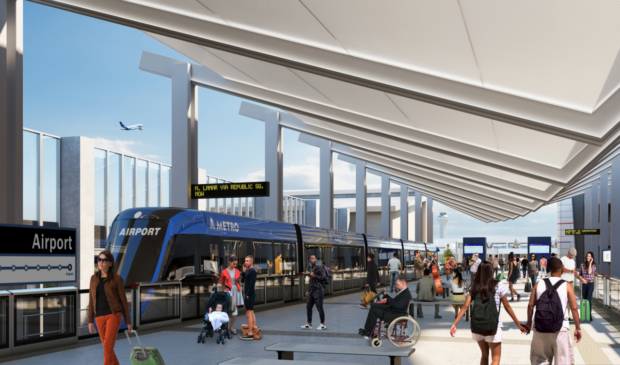Voters pass Project Connect transit plan
Wednesday, November 4, 2020 by
Ryan Thornton With the passage of Proposition A, voters have given the Capital Metropolitan Transportation Authority the green light to build out the core elements of the city’s first mass transit system over the coming decade as part of a $7.1 billion initial investment in the $10 billion Project Connect system.
Capital Metro Board Chair Wade Cooper declared victory for Prop A in a press conference Tuesday night, with the plan receiving nearly 59 percent of counted votes. While Austinites have previously rejected efforts toward mass public transit, Cooper said Project Connect represents a collaborative effort that has been carried to victory by “young voters” who “showed up in droves and took ownership in changing the future for our city.”
Project Connect is expected to remove an estimated 43,000 tons of carbon emissions from the atmosphere each year with its fully electric bus and rail network. The initial investment includes 27 miles of rail service connecting to destinations such as the airport, the Austin FC stadium, Colony Park and the Domain. The plan also includes a transit tunnel to separate the Orange and Blue light rail lines from vehicle traffic in the downtown core, three MetroRapid bus lines, three MetroExpress routes, nine park-and-rides and 15 new on-demand neighborhood circulator zones.
“It has been a long road, but we now have a data-driven, community-designed plan that voters are telling us they want us to build,” Capital Metro CEO Randy Clarke said Tuesday night. Clarke said the next step for the Capital Metro team is to return to work Wednesday and begin work on delivering the MetroRapid projects and MetroRail Red Line improvements that will be among the first completed elements of Project Connect.
Most of the opposition to Project Connect came from precincts in West Austin. Organized opposition to the plan from groups like Our Mobility Our Future and Voices of Austin focused primarily on the plan’s price tag, which will add an increase of under 4 percent to the Austin homeowner’s overall property tax bill, an addition of approximately $284 for a $325,000 home. The opposition groups cast doubt on these estimates, arguing that the expectation of a 45 percent federal match is also a false guarantee that could ultimately fall on the shoulders of taxpayers.
Despite these objections and the economic concerns surrounding the pandemic, the plan had received 227,387 votes by late Tuesday night.
The Austin Coalition for Transit said the vote is the beginning of a long process that will require continued public engagement. In a statement released Tuesday night, the group said, “Project Connect is the largest project our city and Capital Metro has ever undertaken, and implementation will be difficult work. We all have a role to play, both in supporting the agency, and with vigilance to ensure voters get exactly what they approved.”
Council Member Greg Casar called the plan Austin’s “local Green New Deal.”
“This mass transit system will make sure our working people can get around our city, will create thousands of good union-wage jobs, and will put in place clean transportation solutions that fight climate change,” he said.
Besides the transit infrastructure, the approved $7.1 billion plan also includes $300 million to help ensure that low-income and minority communities are not displaced as a direct result of the massive public investment in mobility.
Council Member Ann Kitchen, who also serves on the Capital Metro board, highlighted the importance of the anti-displacement component on Tuesday night.
“I am excited about this opportunity for Austin,” Kitchen told the Austin Monitor. “I especially appreciate the investment the voters have made in a more equitable transportation system. Project Connect serves all of Austin, significantly improves service for East Austin, and commits $300 million for affordable housing, so people can stay in their homes.”
Rendering courtesy of Capital Metro.
The Austin Monitor’s work is made possible by donations from the community. Though our reporting covers donors from time to time, we are careful to keep business and editorial efforts separate while maintaining transparency. A complete list of donors is available here, and our code of ethics is explained here.
You're a community leader
And we’re honored you look to us for serious, in-depth news. You know a strong community needs local and dedicated watchdog reporting. We’re here for you and that won’t change. Now will you take the powerful next step and support our nonprofit news organization?


